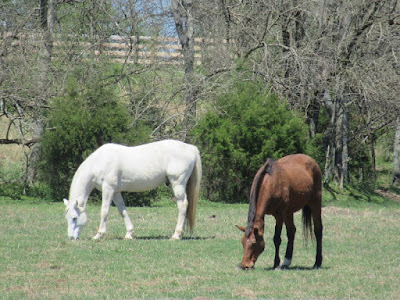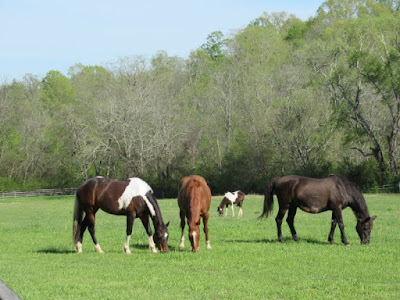Many years ago I enrolled in a course designed to improve one’s ability to speak in public. In the first couple minutes the instructor laid out his program. I’ve never forgotten his words. He said you needed to tell your audience what you were going to tell them in a preface, then you needed to tell them, and then at the end you needed to tell them what you told them. I’m going to live by those words in my basics posts too.
In essence the basics comprise three major things and several minor things. The majors are Forage, Movement, and Friends. Congratulations. Now that you know our secrets I guess my work is done. Thank you very much. Goodbye. :)
Before I go any further I already started this discussion in a previous post titled Getting the Basics Right Won't Fix Every Problem. Melissa warned me in this series not to be too preachy because no one can make everything perfect, and because people like to point out all of the exceptions to the rules. So I covered the exceptions in my first post.
Today I’m going to write a bit of an overview of my topics but my major focus will be on forages, so it will make sense to no one that I’m going to start by talking first about some very basic equine physiology. Horses evolved in such a way that they designed to cover vast distances eating sparse meals quite frequently on relatively poor grazing land. Horses have a small fermentation chamber in their digestive tract (the caecum) that’s purpose built to break down the sort of tough fibre found in dry grass and other plants of the type found in semi-arid regions around the world. Cows also have a fermentation chamber.....a rumen.....but theirs is dramatically larger that a horse’s caecum. Cows evolved to consume vast quantities of grazing material at one time; their rumen is about the same size as a forty gallon drum.....and except for short bursts of speed they are designed to be sedentary. Horses evolved to move constantly. They have evolved to eat many small meals....ten or more.....of low to moderate quality forage over a 24 hour day. They are designed to walk ten to twenty miles to accomplish their ten or more meals a day. Since they are prey animals they very much evolved to be a part of a herd for protection. Thus horses evolved to spend the entirety of their days delineating their place in the herd heirarchy while they were in near constant movement eating many small meals a day
Now that we have some basic physiology out of the way I want you to think about how most horses today are kept and fed at your house, on your farm or in your boarding barn. Is there anything about keeping a modern, high end show horse that mimics how a horse evolved? Is there forage of low to moderate quality available to your horse 24/7/365? How much movement does your horse get every day? Does your horse have the constancy of a herd of friends?
People often ask what the best forage choices are for their horse. My answer is that most horses need a near constancy of low to moderate quality forage in their diet. Except in special situations horses need to get most of their nutrition from forages. One could make the argument that as levels of exercise increase the quality of the forage should also increase but only up to a point. Most horses most of the time don’t need unending quantities of super high end forage in their diet. The first result of feeding forages that are too rich is that we wind up limit feeding them so the horses in question don’t become grossly obese. This results in horses going long stretches of time with no forage in front of them which is frustrating for them mentally. It also has potential physical ramifications. It takes a lot of stomach acid to digest fibrous forage and the act of chewing produces massive quantities of saliva. One of the things saliva does is buffer the pH of equine stomach acid. A lot of horses seem to be able to handle limit fed forages but I am going to wonder out loud just how many cases of ulcers get started through some combination of mental stress (stalled/alone/no forage much of the time) combined with physiological stressors (an excess of stomach acid production combined with no saliva and limited forage to buffer the acid). Our animal management strategies, while convenient for us at times, may well be setting us up to fail with some horses.
I’m going to segue into pasture grass for a moment. I get asked frequently what sort of pasture mix we sow here on the farm. My answer floors most people; whatever grasses were growing here naturally when we bought the farm. To be sure we DO manage the pastures to encourage certain species of grass. We fertilize the pastures repeatedly. We practice various types of weed control every year. At times we manage the grazing pressure on the pastures to reduce wear and tear. Our goal is to enhance what grows here naturally, not change it in favour of “better” forages. We’re far enough south that most of our grazing comes from C4 tropical type grasses. By nature C4 grasses are of lower quality than C3 cool season grasses, and much lower in NSC. This works for us in any number of ways, but if we lived farther north and had pastures full of C3 grasses that is what we would use. We do overseed some cool season grasses in the fall or very early in the spring so horses will have a bit of green material to graze on to supplement their hay during our winters. They get most of their winter nutrition from hay but our goal is to keep enough green material in the pastures that the horses will move around a lot to get a few mouthfuls of it. Horses that are constantly moving across wet pastures make the pastures much less aesthetically pleasing. It also makes them much harder to manage, but it’s so much easier on the horses that we put up with the challenges it brings.
I will get into more detail on all of these topics in later posts.
Sam and Mick
Lofty and Silver
Chance and Convey
Ricardo, Chance and Convey
Penny and Dawn
Asterik, Romeo and Lotus
Happy and Johnny
Gibson and Flyer
Baner, Alfie and Art
Sport and Duesy
Mick, Blu and Quigly
George, Gus and Lofty
Cocomo and Donneur having a grooming session while waiting for the farrier
Sabrina, Acer, Innes and Flower
Renny and Havana
Moses
Cinnamon and Dolly
Cuffie





















































